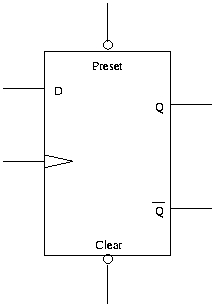Flip-Flops
- RS latches
- level clocking
- D latches
- Edge-Triggered D flip flops
- Edge-Triggered JK flip flops
- JK master-slave flip flops
latches and flip-flops
- memory elements
- two stable states
- remain in one state until triggered into the other
RS latches
- set-reset
- transistor RS latch
- race condition if both inputs are high (low), the final state
is indeterminate (indicated by a "*" in the truth table)
- timing diagram
| R | S | Q | state |
|
0 | 0 | NC | no change |
|
0 | 1 | 1 | set |
|
1 | 0 | 0 | reset |
|
1 | 1 | * | race |
|
|
Switch debouncer
- single-pole, double-throw switch
- open (disconnected) input is high, or can connect to Vcc via a resistor
- metal rubs on metal and contact is made and broken several times
before the contacts come to rest
- we would like a simple, reliable transition
- solution: use RS latch
Clocked latch
- R and S fed through (N)AND gates controlled by a clock
- latch is only controlled when clock is high (low for negative clocking)
- R and S can change arbitrarily while clock is low
- race condition when: clock high, R high, S high
Clocked latch truth table
| CLK | R | S | Q |
|
0 | 0 | 0 | NC |
|
0 | 0 | 1 | NC |
|
0 | 1 | 0 | NC |
|
0 | 1 | 1 | NC |
|
1 | 0 | 0 | NC |
|
1 | 0 | 1 | 1 |
|
1 | 1 | 0 | 0 |
|
1 | 1 | 1 | * |
|
|
D latch
- to avoid race condition, drive R and S from same (inverted) input
- that way, we never have a race condition
- clocked:
- high clock makes the latch transparent, so Q follows D
- low clock makes the latch output fixed
Edge triggering, preset and clear
- often we don't want the value of Q to follow D while CLK is high
- use a capacitor/resistor to generate a carefully controlled
spike when the clock goes from low to high
- that spike is used as the D clocking signal.
- Also, an additional AND gate on the R and S lines can be
used to set or clear the flip flop

Edge-triggered J-K flip flop
- when J and K are both low, circuit is stable
- high J sets the circuit on the rising clock edge
- high K resets the circuit on the rising clock edge
- high J and K toggles the circuit on the rising clock edge
- if the clock pulse is too wide, circuit toggles more
than once, or races
Edge-triggered J-K Master-Slave flip flop
- J-K level triggered flip-flop
- feeds into R-S negative-level triggered flip-flop
- when clock is high, master is active
- when clock is low, master is fixed, slave is active
- if J and K are both high, master toggles when the clock
is high, slave toggles when the clock is low
- cocking -- preparing, on clock high -- and triggering
-- bringing to the outputs, on falling clock
- clock generator

